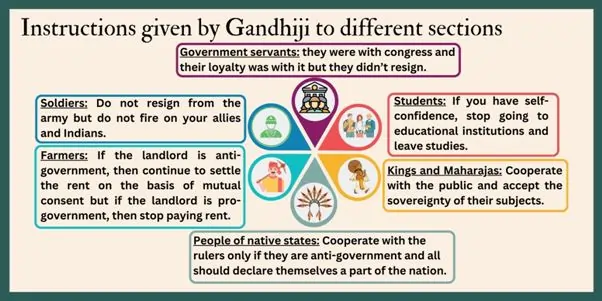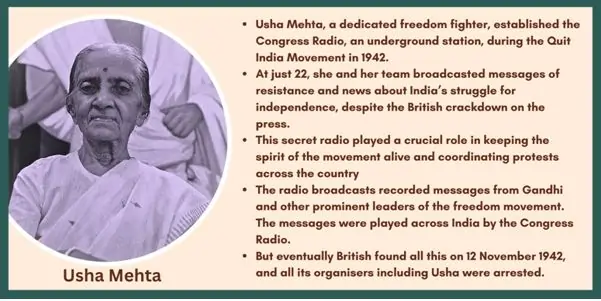After the Cripps Mission, Gandhiji prepared a proposal
which called for the British to immediately quit India and
a non-violent non-cooperation movement as proposed by Gandhiji to
Indians in case of Japanese attack. The Congress Working Committee
in its meeting at Wardha (4 July 1942) gave its approval to the
Gandhian proposal of struggle.
Quit India Movement or Bharat Chhodo Andolan also
known as August Kranti Movement.
Reasons why conflict was inevitable:
The following were the main reasons for the inevitable conflict:
- The failure of Cripps Mission on development of the constitution had disclosed
all of the Britain’s incompetence.It became evident that if Indians
remained silent for an extended period, it would be akin to abandoning
their future to Britain. This would give the British the right to
determine their future without consulting the Indians.
- There was intense discontent among the people
against the government due to the uncontrollable
rise in prices and the shortage of essential
commodities like rice, wheat, salt, etc.
The government had seized the boats of Bengal
and Orissa fearing that they would be misused
by the Japanese, due to which the local people
were facing trouble. Fearing a Japanese attack,
Britain resorted to oppressive and discriminatory
land policy in Assam, Bengal and Orissa.
- The news of Britain's defeat in South-East Asia and the
fall of powerful Britain awakened the will to express discontent
among the Indians. People's faith in the stability of British
rule began to wane and people started withdrawing their money from post offices and banks.
- There was a lot of discontent over the methods adopted by the British government for the evacuation of Burma and Malaya. The government evacuated the settlements of the Europeans and left the local residents to their fate. Two types of roads were built here - a black road for Indian refugees and a white road for European refugees. These actions of the British government dealt a severe blow to the prestige of the British and exposed their superiority complex.
- The leaders of the national movement felt it inevitable to start a struggle due to the fear that the people would not offer any resistance to the Japanese invasion due to despair.
All India Congress Committee meeting at Gowalia Tank, Bombay (8 August 1942):
Quit India resolution was declared and resolutions were passed which were as following:
- British rule in India should be abolished.
- It was declared that independent India will protect itself from all types of fascist and imperialist powers and will maintain its integrity.
- After the withdrawal of the British, a temporary government will be established for some time.
- The civil disobedience movement against the British rule was supported.
- Gandhiji was declared the leader of the struggle.
Instructions given by Gandhiji to different sections:
Although these instructions were announced by Gandhiji in the Congress's Gowalia Tank meeting, but still they were not made public at that time. Under these, Gandhiji had given various instructions to different sections of the society. These instructions were as follows-

- Government servants: they were with congress and their loyalty was with it but they didn’t resign.
- Soldiers: Do not resign from the army but do not fire on your allies and Indians.
- Students: If you have self-confidence, stop going to educational institutions and leave studies.
- Farmers: If the landlord is anti-government, then continue to settle the rent on the basis of mutual consent but if the landlord is pro-government, then stop paying rent.
- Kings and Maharajas: Cooperate with the public and accept the sovereignty of their subjects.
- People of native states: Cooperate with the rulers only if they are anti-government and all should declare themselves a part of the nation.
On this occasion Gandhiji had told the people, 'There is a mantra,
a small mantra, which I give you. You can engrave it in
your heart and express it with every breath. This mantra is -
"Do or Die." Either we will liberate India or we will give our
lives in this effort. We will not live to see the permanence of
our slavery.
Spread of the movement
Gandhiji had created the atmosphere for the movement through civil disobedience, organisational work and continuous propaganda campaign. But the government was neither in favour of any kind of compromise with the Congress nor could it wait for the formal launch of the movement. As a result, it issued orders for arrest and repression. On the morning of 9 August, all the important Congress leaders were arrested and taken to unknown places. With the arrest of these top leaders, the reins of the movement came into the hands of extremist elements among the youth.
Mass Revolt
- The masses attacked the symbols of government power and forcibly hoisted the tricolour on government buildings.
- Satyagrahis courted arrest, bridges were blown up, railway tracks were uprooted and telegraph and telephone lines were cut
- Students went on strike in educational institutions; student processions were taken out, they wrote illegal pamphlets, distributed them everywhere and acted as messengers for underground workers.
- Strikes were there in the Jamshedpur, Poona, Ahmedabad, Bombay and Ahmednagar.
Underground activities
The task of conducting underground activities was mainly in the hands of socialists, members of the Forward Bloc, followers of Gandhi Ashram and revolutionaries. Bombay, Poona, Satara, Baroda and other parts of Gujarat, Karnataka, Andhra, United Provinces, Bihar and Delhi were the main centers of these activities. Ram Manohar Lohia, Jayaprakash Narayan, Aruna Asaf Ali, Usha Mehta, Biju Patnaik, Chhotu Bhai Puranik, Achyuta Parvardhan, Sucheta Kri Palani and R.P. Goenka were among the leading leaders conducting underground activities.
Underground radio was established In the Bombay (present day Mumbai). It was established by Usha Mehta. People involved in underground activities were getting widespread support. They were given arms and ammunition in large quantities. The main objective of these agitators was to attack government buildings, means of communication and transport and other government establishments and to kill those who support the government or spy for the government.

Parallel Governments
An important feature of the Quit India Movement was the establishment of parallel governments in many places in the country:
In the movement general public was at their max to support agitators. No section of the society lagged behind in giving help and support. Industrialists (support in the form of grants, patronage and other things), students (support in the form of messengers), ordinary villagers (refusing to give information about the agitators to government officials), train drivers (by carrying bombs and other essential items in the train) and police and government officials all provided full support to the agitators.
Public participation in the movement
It was at many layers as-
- Youth: mainly school and college students played an important role.
- Women:there was an active participationby students in the movement. Among other women, the names of Aruna Asaf Ali, Sucheta Kriplani and Usha Mehta are prominent.
- Farmers: Farmers of the entire country were the soul of this movement. Farmers, whether rich or poor, played a historic role in the movement. Even some landlords also participated in the movement. Especially the king of Darbhanga, who was also a very big landlord. The farmers targeted only the symbols of British power. (Midnapur), Bihar, Maharashtra (Satara), Andhra, Gujarat, Kerala and U.P. were the main centres of farmers' activities. Government officials, especially officials belonging to the lower strata of administration and police. They also gave important support to the movement, as a result of which the government lost trust in the government officials of this class.
- Muslims: They provided shelter to the underground agitators. There was no trace of communal violence during the movement.
- Communists:most of them at local showed support despite their opposition to the movement.
- Native princely states: Their support was normal.
Government repression
The government resorted to a policy of repression against the agitators and came down to completely crushing the movement. Though martial law was not imposed, the government's repressive action was severe. The demonstrators were mercilessly lathi-charged, tear-gassed and fired upon. An estimated 10,000 people were killed.
The government attacked the press and banned many newspapers. The army took control of many cities and the police and intelligence services became the tycoons. Heavy fines were imposed on rebellious villages and people were publicly flogged.
Evaluation
- The main centres of the Quit India Movement were Eastern Uttar Pradesh, Bihar, Midnapore, Maharashtra and Karnataka.
- Students, workers and farmers were the backbone of the movement, while the upper class and bureaucracy remained neutral in the movement.
- The agitators considered the elements loyal to the government as traitors. The movement made it clear that the feeling of nationalism has deeply penetrated the Indians.
- The movement made it clear that it is no longer possible to rule India against the wishes of the Indians.
- The element of spontaneity was much more in this movement than in the previous movements. Although in the Non-Cooperation Movement and Civil Disobedience Movement (both phases) also the Congress had provided opportunities for the development of spontaneous elements, but in the Quit India Movement of 1942 this element was comparatively much more. In fact, the strategy of the Gandhian mass movement was that the top leadership would plan the program and its implementation would be left in the hands of the public and local level workers. Although the outline of the Quit India Movement was not made clear due to the leadership not getting the opportunity to launch the movement, but once the Congress leadership and Gandhiji defined the movement, everyone got inspired and joined the movement. Apart from this, the Congress was also preparing for this struggle theoretically, politically and organizationally for a long time.
- The immediate Independence being the main theme of the movement gave spark to the freedom struggle. After this movement, the leadership of the Congress and the Indians never softened their stand on this demand.
- The participation of the general public in this movement was unprecedented. People displayed indomitable courage and patriotism. Although the torture they faced was extremely brutal and inhuman and the circumstances of the struggle were also unfavourable for them, but the public played a very commendable role on every front of the movement and provided full support and cooperation to the agitators